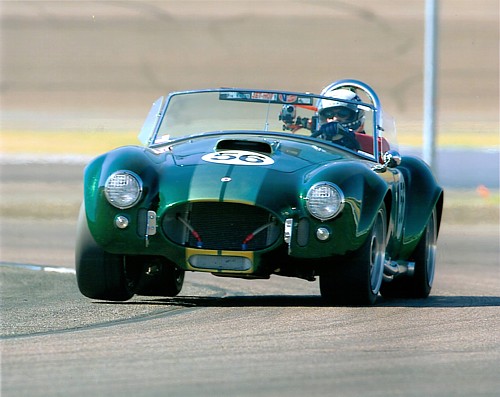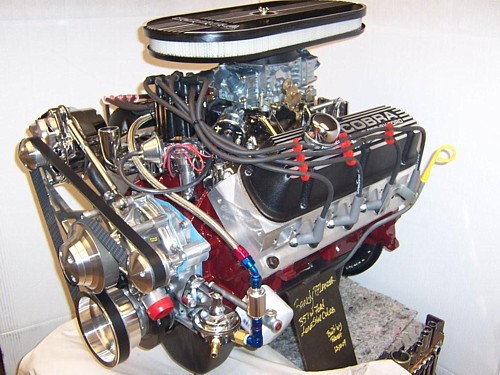
Before
we get into putting
a build specification together, let's define what one is. Basically, a
build specification is a vision, your vision, of what you want
your Cobra to be when you're finished. It's also a roadmap for making
individual project decisions over the course of construction. That doesn't
mean that you put one together and never change it, but taking the time to
put one together will help assure you that your finished Cobra will be
everything you hoped it would. It will also help you avoid filling up your
garage with a bunch of unused, expensive parts. To start a project like
this without a build specification is like building a house without a
blueprint. You probably wouldn't do that, and it's not a good idea when
building a Cobra either.
Okay, so we agree we
need a build specification, so how do we go about putting one together?
First, decide on a tool for capturing your decisions. I put my decisions
into a MS-Excel spreadsheet where I also keep track of my expenses as well.
Use whatever tool you have or are comfortable using. At the end of this
chapter, I'll share with you my build specification document.
To start my
specification, I asked myself four framework questions. One, how do I
intend to use the car? Two, what visual style
am I after? Three, what final finish do I want? Four,
how much power do I need/want? Find your answer to
these four basic questions and you'll be well on your way to establishing
your framework. Let's look at each question in more detail and explore how
to answer these questions to fit your specific situation. Keep in mind that
whatís written below are simply my opinions on what I want to build. Iím
not trying to tell you what you should build nor am I insulting anyoneís
ride if you went in a different direction than I chose. All Cobras are good
in my book.

Photo from
Lone Star Classics Owner Gallery
Use
is referring to how I plan to drive the car. Is this a daily driver, a
weekend cruiser, a track car, a trailer queen show car, or something in
between? This is probably one of the more important questions to get right
because it leads to so many decisions regarding chassis set up, suspension
options, build features, power, tires, etc. Get it wrong and you will waste
a lot of money. Remember that if you want to "track" your car, the SCCA has
some rules that will affect your build like roll bars, restraint systems,
etc. These are easier to do during the initial build than trying to
retrofit later. For me, this was an easy decision. My Cobra will be a
weekend cruiser for me, the wife, and my kids to enjoy. It will have a
touch of show car built in, but not enough that is discourages me from
driving it. I will typically drive it only on nice days and not for
terribly long distances. I don't have any desire to drive uber fast or to
track the car. I'm a little old for that and besides, I used up all my
testosterone (and money) in aviation!

Photo from
Lone Star Classics Owners Gallery
Visual style
is important because it provides a unifying theme that guides all your
detail decisions concerning visual appearance. Am I after the authentic
Cobra look, a custom rod look, or something off the wall that just resembles
a Cobra? I've seen some really wild customs based upon the Cobra body but
that's not quite what I'm after. Besides, this is not a strict show car and
I donít plan on chasing trophies. I also am not interested in the authentic
Cobra look either. There are a lot of stupid arguments on the Cobra Forums
about whether these cars are "real" or a "replica", etc and I don't even
want to get sucked into that dumb argument by trying to emulate an authentic
1966 Shelby 427SC. Besides, I don't really care for the look of the
15" Halibrand knock off rims and white lettered tires. It's too retro for
me. I want more of a custom rod look and feel while retaining the
traditional Cobra body look. I refer to this as the ďcustom CobraĒ look.
This frees me up to experiment with a lot of other options like engine,
interior, sound, rims, tires, and paint. I want to capture the general look
of a Cobra but with the convenience of modern technology.

Photo from
Lone Star Classics Owners Gallery
The finish
of the car is basically a question of money, but it is also a function of
use as well. If you are doing a daily driver, it wouldn't make much sense
to spend big dollars on a high-end paint job. If you are tracking the car,
a can of primer is all you may need. Since mine is a weekend cruiser I can
go inexpensive and simple, expensive and elaborate, or somewhere
in-between. My past experience in aviation has taught me that resale value
is directly proportional to the paint job. I plan on a professional paint
job, not one that I will do at home. I also like my projects to have a
little extra than the next guy so Iím planning on some airbrush work that
for now will remain secret. I have already picked the primary color of the
car but the trim colors are still undecided. Overall, I would say my finish
decision is a notch or two under ďshow qualityĒ and several notches above
your average Blue with dual White stripes (not that thereís anything wrong
with that!) Iíve budgeted around $7K for the prep, paint, and artwork.

Photo
courtesy of The Engine Factory
Ah power,
isnít that one of the reasons we choose to build a Cobra? Hereís where some
of the previous framework decisions interact with personal choice. Basic
choices are big block or small block, and which make (Ford, Chevy, Chrysler,
or other). If youíre going for the replica look, then you will
probably want a 427 FE sideoiler or at least, a newer 428. Most people
consider it sacrilegious to put anything other than a Ford under the hood
but there are a fair number of Chevy drivers out there. I talked to a guy
in Dayton Ohio who has a Cobra with a Viper V-10 engine in it! Use also
plays a role. If you are driving around town, you will want something that
is dependable, easy to clutch, and wonít scare little children. If you are
going to the track, the more HP you can get down to the rear wheels the
better. This is one area where your options are virtually unlimited based
upon personal choice and wallet size. Since I want an easy driver and
dependability, Iím going with a Ford 351W engine bored and stroked to
produce about 425 HP and 400 ft/lbs of torque. For as light a car as the
Cobra, this combination will still be scary fast but easier to maintain than
a big block. Again back to style, I donít care that I donít have a 427
under the hood. Noise is also a consideration and Iím not interested in
telling my neighbors 5 miles away that Iím out for a cruise. The small
block should work just fine for what I want and in the end, probably wonít
affect resale value much.
Here is the link to my
Build Specification document.
This single document reflects the choices I've made as documented above and
includes:
- The parts I need/have
purchased
- The parts I excluded
from Lone Star on the initial order
- The total cost of the
build excluding any tools
- Ddifferent
specifications that are important to remember
- Construction
reminders that I picked up from other builders on the forum
Remember that this document is a living, breathing document and I change it
often. What you download now will likely change over time so keep that
in mind if you chose to use it for yourself. I'll try to keep the
updated version posted to the web.
So, the framework is
established. Now it's time to start ordering stuff and making
decisions about who to buy from. That's covered on the next page.
|







